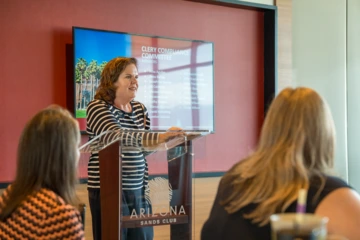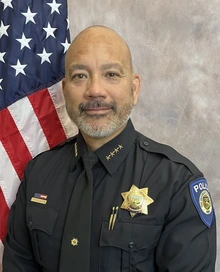Cross-campus collaboration earns the U of A national recognition in campus safety

The award recognizes a transformative effort to move the university from a decentralized approach to Clery to one that is collaborative and community-centered.

Chief Compliance Officer Mary Beth Tucker speaks at a recognition event thanking partners for the team effort behind the Clery compliance award win.
Offices and units across the university have worked together to transform how the institution complies with the Clery Act – the federal law requiring colleges to report campus crime statistics, issue timely warnings and make safety resources available. This summer, that yearslong effort earned national recognition: The University of Arizona received the 2025 Most Improved Clery Compliance Program award from the National Association of Clery Compliance Officers and Professionals.
The Clery Act incorporates four federal laws: the Jeanne Clery Campus Safety Act, the Drug-Free Schools and Communities Act, the Stop Campus Hazing Act and the Violence Against Women Act, all designed to promote safety for students, employees and visitors.
"Put simply, Clery is focused on campus safety and providing information to students, employees and families about resources, procedures and crime statistics to help keep them safe," said Mary Beth Tucker, chief compliance officer. "Compliance requires collaboration across campus — multiple units working together to respond to incidents, support victims and ensure accurate reporting."
The award recognizes a sweeping set of changes that reshaped how the university approaches safety through leadership, training and reporting.

SevaPriya Barrier (left) and Mary Beth Tucker enjoy the award recognition event at the Arizona Sands Club.
The path to improvement
The focus of the transformation effort was to move the university from a decentralized approach to Clery to one that is collaborative and community-centered.
"A few years ago, we moved Clery Act compliance responsibilities from the University of Arizona Police Department to University Compliance," said SevaPriya Barrier, executive director of University Compliance. "This was because we recognize that most aspects of Clery compliance are not policing in nature, but require continual institution-wide assessment, planning and monitoring and positive and proactive collaboration across the university."
As part of the work, University Compliance formed the Clery Compliance Committee, which includes representatives from 11 units throughout campus, the Clery Campus Classification Workgroup, which reviewed 33 university properties, and the Violence Against Women Awareness workgroups, which annually organize three month-long campaigns.
With the new organizational structure in place, the university made several upgrades to its compliance, including:
- Creating an accessible Annual Security and Fire Safety Report consolidating information from nine campuses.
- Overhauling training for more than 2,000 Campus Security Authorities – people in roles like coaches, advisors and housing staff who students often confide in.
- Developing an interactive Clery map in partnership with the university's Enterprise Geographic Information System team.
A team effort
Clery compliance is not the responsibility of any one office or department, but an institution-wide commitment. University of Arizona Police Chief Chris Olson said he is grateful for the collaborative approach.
"We spent many meetings making sure we truly understood what was being asked of us — from how we issue timely warnings to how we complete daily activity logs to the level of detail required in our reports. It was about making sure we captured crime data accurately and consistently."

Chris Olson
Amanda Kraus, vice president for Student Affairs, and her team also partnered in the effort. She said the work is challenging but essential to building confidence in campus safety.
"Safety is critical to student success, personally and academically," Kraus said. "Accurate, timely and clear information may feel unsettling at times, but it empowers students and community members to make better decisions and understand community dynamics. That foundation is essential to feeling comfortable, getting involved and growing as a student."
Pushing forward
The recognition from NACCOP is important validation for the work the team has done so far, but Barrier said the goal is continuous improvement.
"Clery compliance is not a one-time project," Barrier said. "It requires a continual process of prevention, education, communication and transparency. We've made tremendous strides, but we are committed to ongoing improvements year after year."
Recent upgrades reflect that commitment. The university enhanced its UAlert emergency notification system and launched SafeCats, an app providing quick access to safety information and resources in one place.

Amanda Kraus
UAPD also upgraded its safety tools by building a geofence — a virtual boundary created with GPS technology — around campus that extends several blocks.
"That means if a violent crime happens nearby, we get notified in real time and can decide whether to send a UAlert," Olson said. "It gives us the ability to address threats before they reach campus."
Showing appreciation
Partners in the effort gathered Aug. 19 at the Arizona Sands Club to celebrate the recognition and the collaboration, built on trust, transparency and shared responsibility. In her remarks at the event, Tucker thanked attendees for their commitment.
"Today reminds us of what is possible when we come together, when we support one another, uphold our shared values, and keep care and safety at the heart of all we do," Tucker said.

